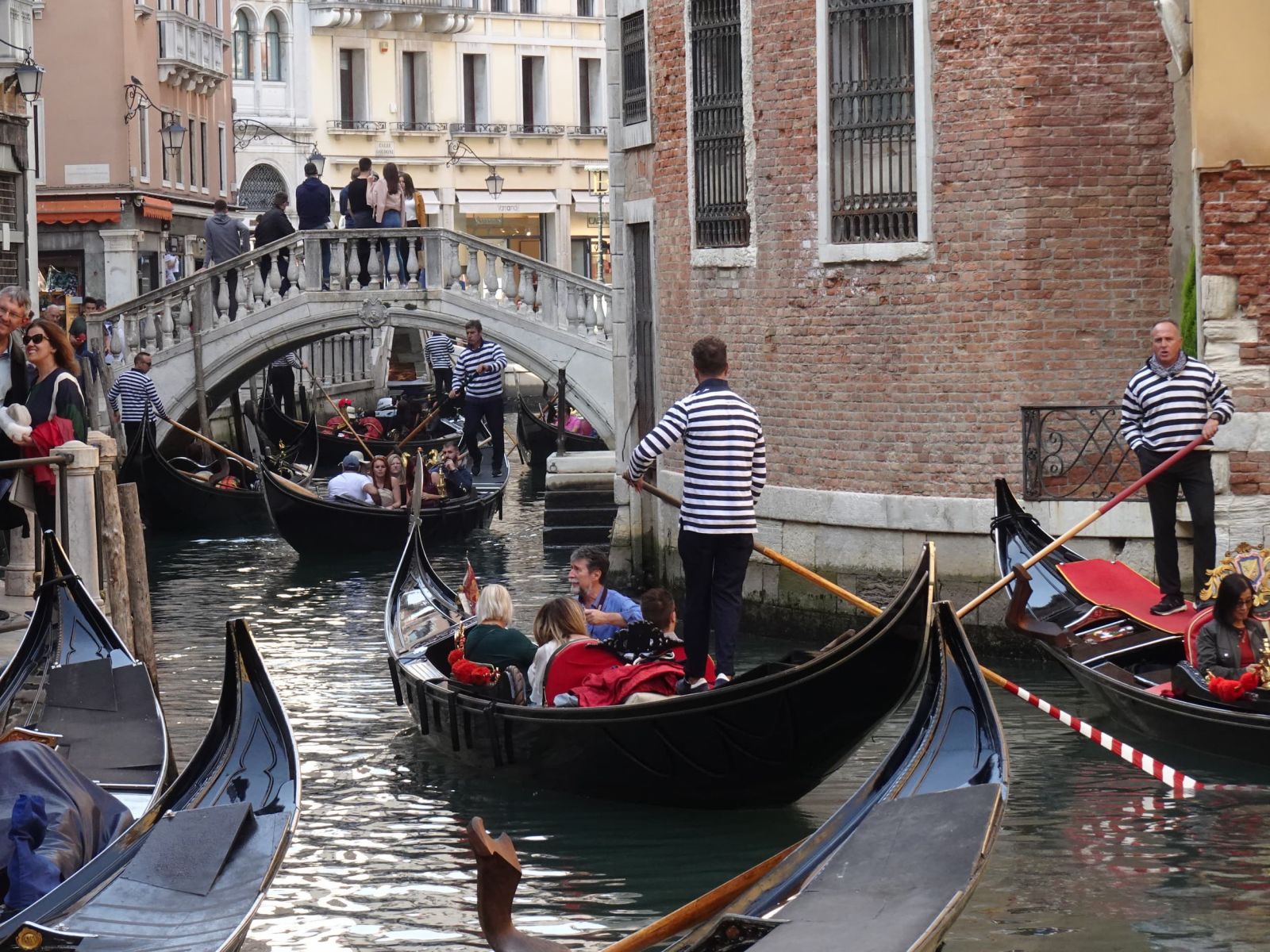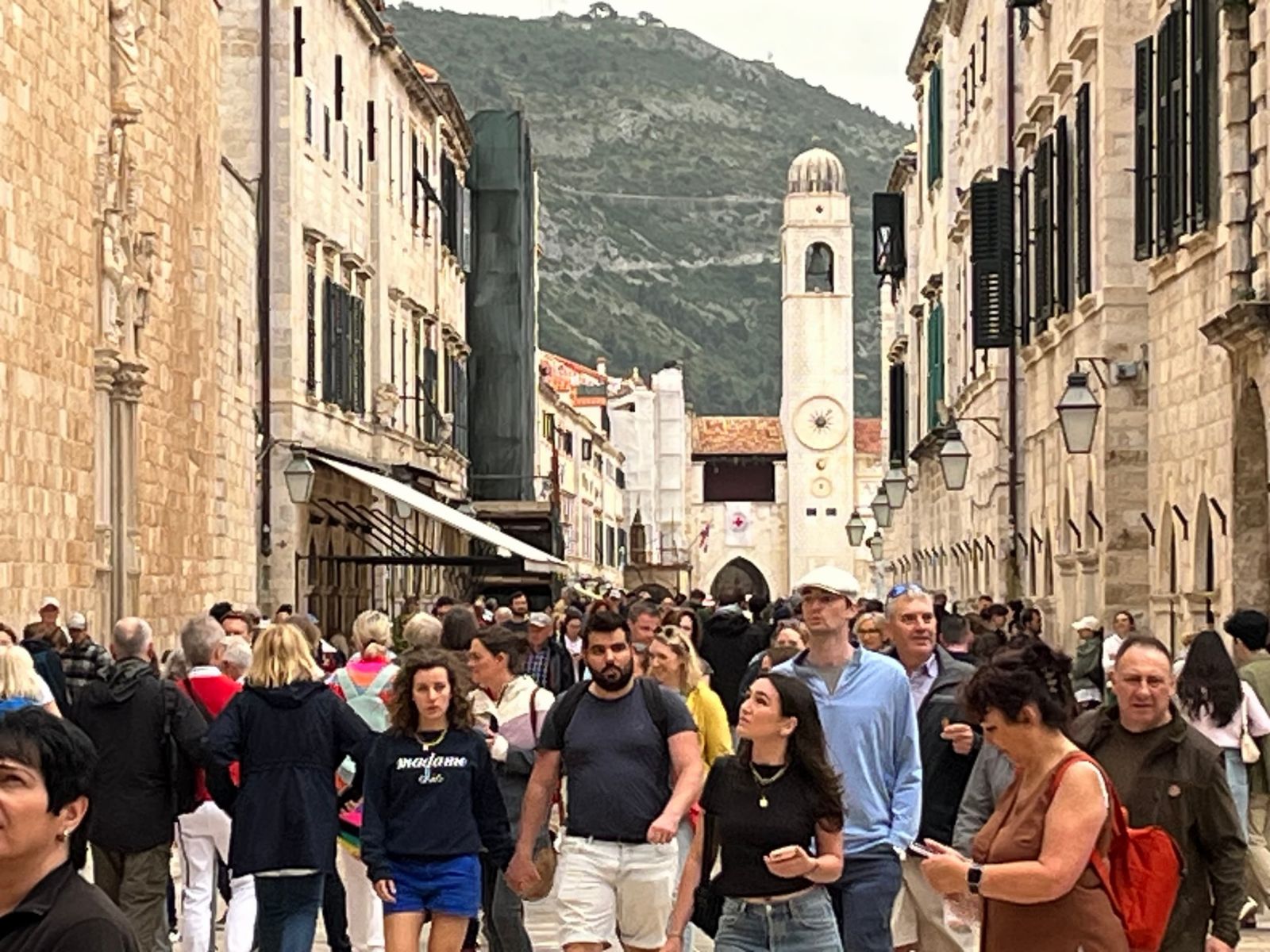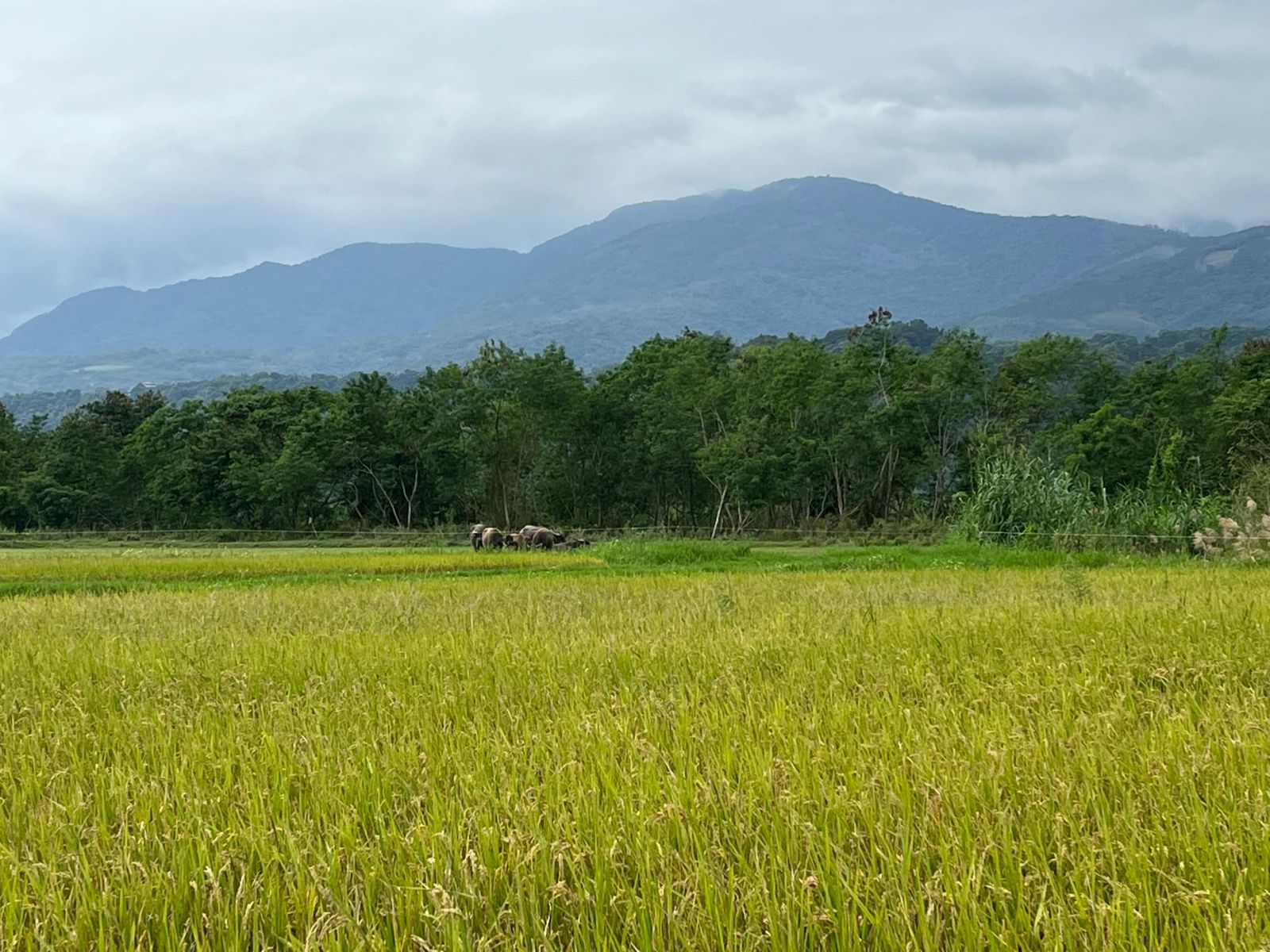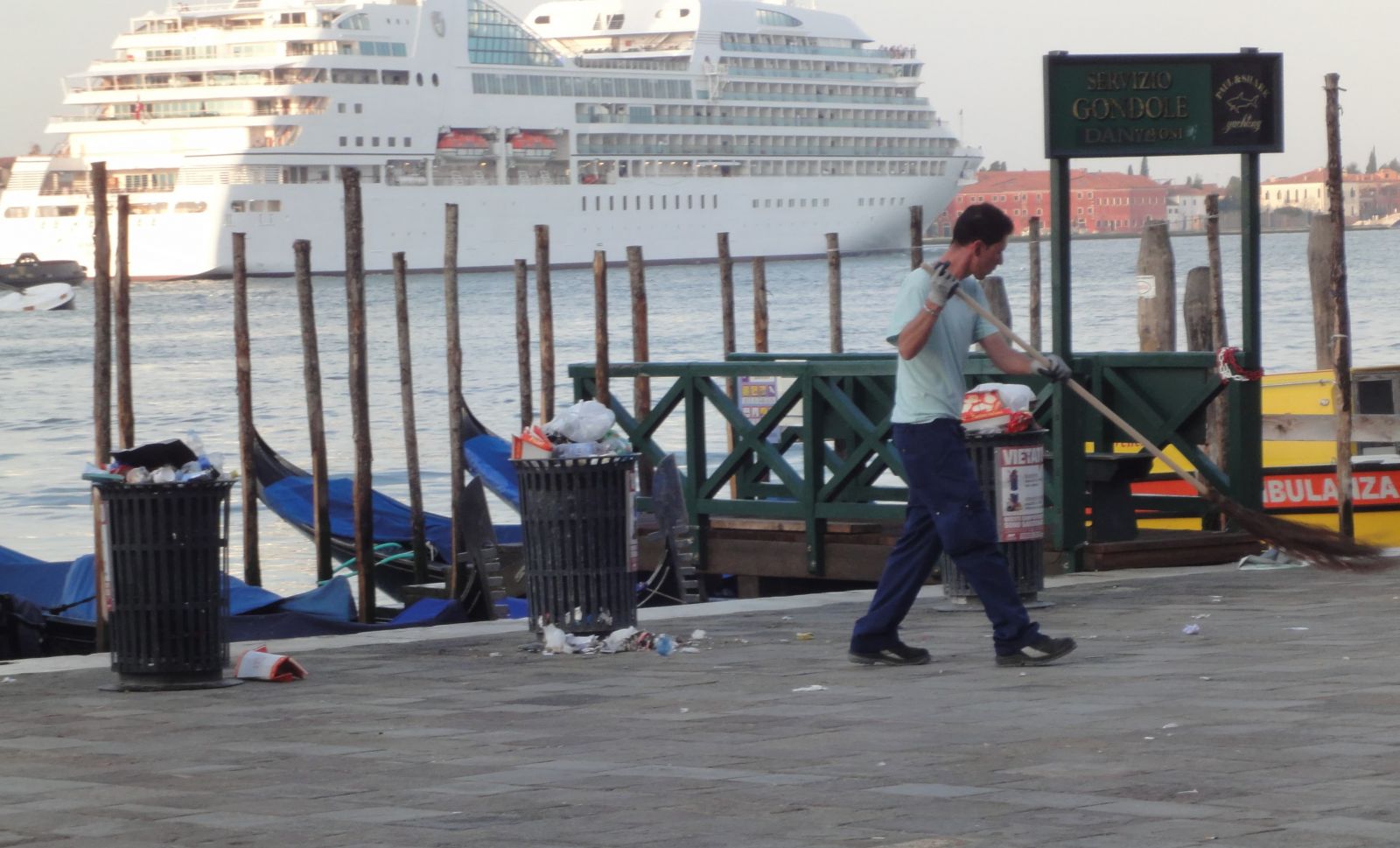Life & Art
"人山人海" – Can Taiwan avoid the scourge of overtourism?
By Mike Jewell

The joys of floating along the canals of Venice. Photo credit: Mike Jewell
“The Lido, with its acres of sun-pinked or pyjamaed bodies, was like a strand with an endless heap of seals come up for mating. Too many people in the piazza, too many limbs and trunks of humanity on the Lido, too many gondolas, too many motor-launches, too many ices, too many cocktails, too many menservants wanting tips, too many languages rattling, too much sun: altogether far too much enjoyment!”
DH Lawrence, Lady Chatterley’s Lover
DH Lawrence’s picture of holidaying in Venice in the 1920s is remarkably similar to what greets visitors in 2023. The big difference between travelling then and now, though, is that so many more people are doing it. In the 1920s, holidaying abroad was reserved for a privileged elite. Even in 1950, before commercial jet travel became a reality, international tourist arrivals globally totalled a mere 26 million.
Since then vacation travel has exploded with seven decades of unfettered growth, propelled by a rapidly expanding middle class, eager to “see the world”. By 2000, the number of international tourists had risen to 680 million and, in the next two decades, the number more than doubled to 1.4 billion. Of course, Covid brought everything to a shuddering halt, but only temporarily as a strong recovery got into full swing last year. A return to rapid annual growth is not far away. Some projections are for 3 billion holiday travellers by 2050.
Desperate to cash in, local and national governments have focused on maximising visitor numbers year after year, in a relentless pursuit of tourist dollars. Crossing international borders has been made increasingly easy, while subsidised jet and cruise liner fuel has encouraged more travel by keeping costs down and the whole travel environment has undergone massive change.
A multitude of regional airlines now criss-cross Europe, Asia and elsewhere offering budget flights to popular holiday destinations; floating cities move people efficiently from one tourist hotspot to the next; home share companies (Airbnb and others) have massively increased the availability of vacation accommodation; and digitisation has made foreign travel so much more accessible.
The internet puts once remote places at our fingertips, bombarding us with reviews and introductions from influencers, and with every imaginable scrap of information we might want to know. There is online booking of everything, from visas and flights to accommodation, taxis and holiday activities. And social media fuel an insatiable desire to be there and share the pictures with the whole world.
The travel and tourism industry has become a significant component of the entire global economy. According to the World Travel & Tourism Council (WTTC), prior to the pandemic, the sector accounted for 10.3% of global GDP, worth US$9.6 trillion. It was responsible for one tenth of global employment, with a workforce of 333 million. Meanwhile, international visitor spending across the globe amounted to US$1.8 trillion, 6.8% of total exports.
Covid’s catastrophic impact on the industry is well documented. While global GDP declined by 3.3% in 2020, the contribution of travel and tourism crashed by 50.4% and almost one fifth of the sector’s work force were made redundant. Despite governments’ efforts to minimise the negative impact, every business suffered and tens of thousands were forced to shut. The loss of livelihoods was devastating.
Despite the hardship visited on so many, the overall outlook for the travel sector is positive. The WTTC were particularly bullish in their most recent report, projecting 5.8% annual growth for the next decade and 126 million new jobs.
“It is the fate of all great tourist spots to become terrible tourist spots because as soon as everyone finds out they’re great tourist spots, they fill up with tourists.”
Ben Pobjie, Australian writer

Dubrovnik…out of season! Photo credit: Mike Jewell
Tourism’s importance to the global economy is clear from the GDP and employment figures I quoted earlier and there are numerous potential benefits for countries able to attract a steady flow of foreign visitors.
Investment in better airports, roads, water supply, energy, digital infrastructure, and medical services to service visitors also benefits the local population, and jobs are created both within the tourism sector and throughout the broader supply chain.
Many cities implement regeneration projects, while new life can be breathed into local communities, reversing decline and preserving local arts and culture, music, and traditional industries.
Tourism safeguards important cultural sites, as visitor spending on entrance tickets, guides and souvenirs contributes funds essential for the upkeep of these sites.
Tourism can be especially beneficial to lower income economies. Countries such as Thailand, Cambodia, Croatia, Greece, Portugal, and many others rely on spending by international travellers for over 10% of GDP (compared with 1.9% globally) and it is an invaluable source of foreign currency.
At the human level, tourism can facilitate intercultural understanding.
So that’s all good then……isn’t it?
With more and more people wanting to drop their money in foreign places, no wonder governments and businesses are going out of their way to welcome the growing tide.
But this is coming at a cost and the new buzz word is overtourism, recognising that uncontrolled growth in numbers brings at least as many problems as benefits, forcing a rethink in strategies.
Overtourism is the result of mismanaging the tourism process, causing dissatisfaction among visitors and, more critically, damage to the fabric of the sites themselves, and giving rise to bad feeling and hostility among the local community.
The sheer volumes of foreign visitors detract greatly from the “tourist experience”, with traffic congestion caused by too many tourists buses, restaurants filled to overflowing with cruise passengers, and how can you get a clear sight of a famed museum exhibit or artwork from behind ten rows of tourists, all pushing and shoving to get to the front?

St. Peter’s Church, Vienna. Photo credit: Mike Jewell
However, the more serious result of overtourism is the effect it has on the places people visit. Despite the potential benefits, the reality is that hordes of visitors descending on places do untold harm. In their eagerness to get up close and personal with world famous sites, travellers do irreparable damage. Every footstep wears away the surfaces and impacts the ecosystem. Then there is the inevitable detritus and less responsible visitors who are not above leaving unwanted records of their visits scratched into ancient stone or wood.
Think about the desperate state of Boracay. Conde Nast Traveler described the island as “the poster child for overtourism” and the government had to close it for six months to clean it up and impose much tighter regulations to prevent the same degradation re-occurring.
And Thailand’s Maya Bay, which suffered from mounting piles of garbage, disappearing wildlife and destruction of its coral, until the authorities closed it for four years and now have imposed very tight controls on visitor numbers and behaviour.
Europe continues to receive the majority of international visits and last year had already returned to 95% of pre-Covid volumes. In the most popular cities, resident populations have been overwhelmed by the numbers of tourists and often repulsed by their boorish and loutish behaviour, while tourist-oriented businesses, eager to cash in, push out long-established community services.
Amsterdam is a classic example. A city of just over 900,000, it hosted over 20 million visitors in 2019, giving rise to serious concerns over public safety as the narrow streets and alleyways of the most popular districts were packed with humanity throughout the high season.
Then there is tourist behaviour, as young partygoers flock to Amsterdam for weekend binges of alcohol and cannabis and endear themselves to the locals by urinating in the canals and vomiting over ancient doorsteps, leaving trails of litter behind, and making a general nuisance of themselves long into the night.
The old centre of the city is no longer home to locals, as shops selling wooden tulips, and all types of tacky tourist tat or cannabis seeds have replaced chemists, greengrocers, and hairdressers. There is no longer space for doctors’ clinics or other local services and the rise of short-term holiday property rentals has made much of the city centre unaffordable for ordinary people.
Often unregulated, home shares offer accommodation at attractive rates in already saturated districts, and as the concept becomes ever more commercialised through platforms like Airbnb, the demand for apartments means that rents are pushed up, and beyond the reach of locals.
Barcelona offers a different, but no less depressing snapshot of overtourism. The largest port in the Mediterranean, it is a prime destination for monster cruise ships. Throngs of passengers spend just a few hours in the city, ticking off a limited number of popular spots. Little money is spent outside of the main tourist cafes and souvenir stalls, and the congestion is unpleasant for both residents and other tourists. It has been described as like a “tidal wave” when, after breakfast on board, as many as 35,000 people arrive at the Mirador de Colón, to walk up La Rambla.
Overtourism alters the fundamental character of destinations. With locals gone, the authenticity of the experience for travellers is also lost. The goal of injecting new life into traditional communities and preserving rapidly fading indigenous culture is little more than an idealistic fantasy. Commercialisation can undermine the soul of a tourist destination and rich cultural heritage is reduced to wearing costumes and putting on acts for the tourists in return for money.
A growing backlash from locals in many popular cities hit the headlines in 2017, with protests in a number of top tourist destinations – Barcelona, Mallorca, Venice, Athens, Lisbon, Amsterdam, and others. (On my last visit to Amsterdam I was lectured by a taxi driver about all the problems caused by too many visitors. It was hard to disagree with him).
In response, local administrations are taking notice and introducing measures to try to manage the situation. Caps on daily visitor numbers are being introduced; cruise ships are being banned or at least their numbers strictly controlled in places like Venice, Dubrovnik, Amsterdam; tour buses are being banished to city outskirts; some places require visitors to buy permits; stricter controls are being brought in to counter anti-social behaviour and hefty penalties enforced on transgressors.
Restrictions on access have also been introduced at vulnerable historic sites, such as the neolithic stone circle at Stonehenge, the Inca citadel of Machu Pichu, the Parthenon in Athens, the priceless natural habitats of the Galapagos Islands, and the temples at Angkor Wat in Cambodia.
It remains to be seen whether these measures will be successful in mitigating the excesses of overtourism, especially in the face of growing consumer demand, but at least there is now some recognition that the headlong pursuit of ever-increasing visitor numbers carries considerable risk.
The European Travel Commission weighed in on the discussion in its latest quarterly report:
“[Overtourism’s] negative impacts on tourism sites, the environment and the lives of residents call for destinations to offer more alternative options and implement strategies that ease the pressure on tourism hotspots. Tourism strategies that embrace travel dispersal will support destinations in addressing tourism massification while spreading the benefits of tourism to lesser-known areas. Tourism should be leveraged as a force for good to balance economic growth with current social, economic and environmental needs to ensure a responsible and more sustainable future.”
European Travel Commission, Quarterly Report Q2/2023
And what of Tourism in Taiwan?
 The Eastern Rift. Photo credit: Mike Jewell
The Eastern Rift. Photo credit: Mike Jewell
The travel sector in Taiwan has followed a similar path to the global trend, albeit over a shorter timespan in line with Taiwan’s more recent emergence as a developed nation. In 1987, coinciding with the lifting of martial law, the number of overseas trips surpassed one million for the first time. By 2000, the total was 7.3 million.
At the onset of Covid, the yearly total of foreign visits by Taiwanese had leapt to over 17 million and 35% of the population were going abroad at least once a year, predominantly for holidays.
Inbound tourism has been slower to develop but was growing at around 6-7% a year before border controls were introduced in 2020. In 2019, a record 11.8 million international visitors pumped US$14.4 billion into the Taiwan economy. This was supplemented by a robust level of domestic travel worth US$12.7 billion.
The WTTC estimated that tourism made up 6% of Taiwan’s GDP and employed 803,000 people, 7% of the total labour market.
Then Covid happened and the world fell apart. Tourist arrivals dropped by 88% in 2020 and, unlike most other countries, fell again in 2021 to a meagre 140,000, decimating the industry. Travel agencies, hotels, restaurants, airlines and a whole host of ancillary businesses were all badly affected, many of them terminally. With few guests, hotel turnover fell by one third in 2020 and by a further 16.4% in 2021, dropping to its lowest level since 1999.
Fortunately, the industry’s fortunes turned the corner in 2022 and this year Taiwan is firmly on the road to recovery, as Taiwanese have seized the opportunity to indulge their wanderlust once more. By the end of June, there had been 4.9 million departures for foreign shores, suggesting that outbound travel could be pushing towards 60% of its pre-Covid level by year end.
Arrivals reached 2.7 million in the first half of 2023, with the Ministry of Transportation & Communications (MOTC) confident that the full year number will hit 6 million. This is a slower recovery than for outbound travel and a large proportion of arrivals have been on business trips, but inbound numbers are at least picking up.
Building a strong and vibrant tourism industry has been a key component of government strategy for many years. The MOTC’s Tourism Bureau is currently implementing the “Taiwan Tourism 2025” plan, launched in 2020. The plan was formulated under the shadow of Covid, with an urgent need to revive the sorely wounded tourism sector, but, at the same time it set out a longer-term vision to transform Taiwan into a major tourism hub, recognising that tourism is a powerful engine of economic development.
The initial focus has been on revitalising the domestic sector and building back tourist infrastructure, laying the groundwork for the second stage of the plan, which will focus on driving up inbound visits.
In 2023, US$174 million of last year’s surplus tax revenue have been earmarked for promoting Taiwan abroad. Advertising campaigns are being supplemented by a wide range of incentives for travellers and for tour group operators. There is a lucky draw for arriving visitors, with the chance of winning NT$5,000 stored value cards, there are 2-for-1 deals on high speed rail tickets and discounted fares bundled with air tickets and there are free half-day tours for transit and transfer passengers. Meanwhile there is also financial support for hospitality providers, helping them to staff up again and ensure the high levels of service tourists expect.
All of these measures are designed to boost arrivals well beyond 2019’s record and onwards to 16 million by 2030.
One dilemma facing policymakers is the issue of visitors from mainland China. In 2019, almost one quarter of all arrivals came from China. The authorities are hoping for around 1 million this year (17%), despite the ongoing ban on organised Chinese tour groups.
With cross-strait tensions showing no signs of abating, it is no surprise that the Tourism Bureau is focusing its efforts elsewhere. South Korea and Japan, the top sources of arrivals, head the list of priority targets, followed by Europe, North America and the 18 countries encompassed by the government’s southbound policy.
A key question is can Taiwan meet its ambitious growth targets and, at the same time, avoid the problem of overtourism? We have already had a taste of what can go wrong, ironically enough during the pandemic, when, denied the chance to go abroad, people flocked to accessible scenic parts of Taiwan. The eastern parts of the mainland and the outlying islands were suddenly swamped with visitors. They were largely unprepared to handle the influx, while local ecosystems were damaged by unthinking visitors. Writing in Euroview in 2021, Joanna Lee described some of the problems. Penghu, Orchid Island and Green Island all suffered from damage to coral reefs, insufficient water supply, mounting piles of rubbish, traffic congestion, and overworked sewage treatment facilities, leading to raw sewage being discharged into water courses and the sea. Meanwhile, in Hualien, fragile organic rice terraces were trampled under the careless stomp of visitors and polluted by individuals’ use of chemical insect repellents.
At the time, community leaders in the islands called for visitor numbers to be limited, but local administrations were in no mood to listen. That surge has now subsidised, but it could be a foretaste of what is to come if tourism is not managed sensitively.
The Tourism Bureau’s white paper, “Taiwan Tourism 2030” sets out a framework and strategy for tourism management, with frequent references to “sustainable tourism” and a commitment to national and international Sustainable Development Goals and the tourism policy brief for 2023 suggests “the government will…adjust its strategies towards sustainable and green tourism.”
So, the right noises are being made, but the goal of this latest plan, as with all the others since 2002, is growth and growth carries considerable risk for society, particularly as there will inevitably be conflict between commercial interests and environmental concerns. Too often commercial interests come out on top.

Venice, the daily clean-up. Photo credit: Mike Jewell